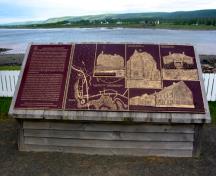Annapolis Royal Historic District National Historic Site of Canada
St. George Street, Annapolis Royal, Nova Scotia, B0S 1A0, Canada
Formally Recognized: 1994/06/05
Other Name(s)
Annapolis Royal Historic District National Historic Site of Canada
Annapolis Royal Historic District
Arrondissement-Historique-d'Annapolis Royal
Port-Royal
Links and Documents
Construction Date(s)
1605/01/01
Listed on the Canadian Register: 2010/04/22
Statement of Significance
Description of Historic Place
Annapolis Royal Historic District National Historic Site of Canada is situated at the junction of the Annapolis and Allain Rivers, in Nova Scotia’s Annapolis Valley. The district’s historic core, consisting of commercial, military, and residential districts, lies at the centre of the original early 17th-century Acadian area of settlement. The district extends back from the waterfront, encompassing a densely built collection of 18th- through early 20th-century buildings exhibiting the Maritime vernacular interpretation of several architectural styles. The town’s strategic setting, bordering the protected Annapolis Basin with access to the Bay of Fundy, made it the site of pivotal events throughout the early years of colonisation in Canada. Official recognition refers to the historic district and its constructed and natural features at the time of designation.Heritage Value
Annapolis Royal Historic District was designated a national historic site of Canada in 1994 because:- it possessed a distinctive sense of both history and place by virtue of its strategic siting, its role as a colonial capital and commercial centre and its association with the historical themes of early Acadian settlement, all of which are represented physically through its evolved town site plan, surviving fortifications and waterfront installations;
- the historic district contains an extensive catalogue of Maritime and Canadian architectural styles of the 18th, 19th and early 20th centuries and the town site, its buildings, sites and open spaces retain an excellent degree of integrity with few inharmonious intrusions.
French colonists first began to cultivate Annapolis Royal Historic District, then known as Port-Royal, in 1605, but in 1613 the colony was seized by the British. In 1632, Acadia was restored to France by treaty after which the site was fortified and became the principal settlement of Acadian colonists. In 1643, a four-bastioned earthwork was constructed at Fort Anne, and by 1650 the beginnings of a town site existed. St. George Street, a main road of the district, was well developed by 1686. Acadia was ceded to Britain in 1713, and Port-Royal was re-named Annapolis Royal. It served as the centre of military and administrative operations for the new British colony of Nova Scotia until 1749 when Halifax became the provincial capital. By virtue of its waterfront location, Annapolis Royal was well established in shipbuilding, brick manufacturing and lumber milling, which expanded and diversified the local economy.
Annapolis Royal is characterized by continuous development, resulting in a wealth of architectural styles and the evolution of five distinct subdistricts within the site. The first subdistrict is distinguished by grand houses on large lots, reflective of the prosperity of its shipping merchants. The second subdistrict, a transitional area between residential and commercial districts, is distinguished by smaller houses with less pronounced set-backs. Landscapes such as the old cemetery and Fort Anne link it with the earliest decades of permanent European settlement. The third subdistrict was developed as a commercial district, and exhibits a variety of architectural influences, harmonized through the use of similar construction materials. The fourth subdistrict, located on Lower St. George Street, contained some of the town’s river-based commercial and industrial enterprises and housed some of the most prominent citizens as reflected in the grand homes. The fifth subdistrict is a residential area, characterized by buildings of modest size and design, which housed tradesmen, shopkeepers, and proprietors of small business.
The town retains extant buildings and structures from all but the earliest of these periods, and as such contains a detailed catalogue of Maritime and Canadian building traditions. Widely regarded as the oldest continuously inhabited settlement in Canada, this exceptional collection of buildings reflects the themes of Acadian settlement, as well as the building of colonial capitals, Loyalist towns, and 19th-century commercial centres.
Sources: Historic Sites and Monuments Board of Canada, Minutes, June 1994, June 2005; Plaque Text, 1997.
Character-defining Elements
Key elements that contribute to the heritage character of the site include:- its location within the town of Annapolis Royal, Nova Scotia;
- the peninsular shape of the townsite, bordered by the Annapolis and the Allain Rivers;
- the informal town plan, evolving with the L-shaped axis of St. George Street;
- the evidence of the original Acadian long, narrow lots and well-treed lots and streetscapes;
- the traditional construction methods, including load-bearing stone, brick, heavy timber and nogged and clay-lined framing;
- the natural finishing materials, including brick, wood shingle and clapboarding;
- infill buildings that harmonize with the early buildings;
- viewscapes to and from the various subdistricts of the site, as well as across the Annapolis and Allain Rivers, and the Annapolis Basin.
Key elements that contribute to the heritage character of subdistrict one include:
- the 19th- and 20th-century buildings set back from the street on large lots;
- the homogeneous nature of the residential streetscape, exhibited in the aesthetic quality and superior craftsmanship of the buildings;
- the spatial characteristics between the buildings and the green spaces;
- the varying architectural styles, including Gothic, British Classicism, Neoclassical, Queen Anne Revival, Colonial and Italianate;
- the harmonious design elements, including wood siding, gable roofs, verandahs and projecting bays.
Key elements that contribute to the heritage character of subdistrict two include:
- the urban streetscape of smaller lots and setbacks;
- the 19th-century two-and-a-half-storey residential and commercial buildings that feature both Gothic Revival and Queen Anne Revival architectural styles;
- the landscaped grounds of the old town cemetery and of Fort Anne National Historic Site of Canada;
- the location of the town’s principal intersection, reinforced by the Annapolis County Court House National Historic Site of Canada.
Key elements that contribute to the heritage character of subdistrict three include:
- the integration of 18th-, 19th- and 20th-century commercial buildings;
- the varying height, massing, architectural style and roofline of the buildings;
- the presence of Sinclair Inn / Farmer’s Hotel National Historic Site of Canada, with its Palladian and classical style inspirations;
- the overall cohesion in the materials and fenestration of the buildings, as well as similarities in aesthetic details, storefront designs, and cornice lines;
- the contours of the corner buildings that adapt to the street curvature.
Key elements that contribute to the heritage character of subdistrict four include:
- the concentration of 18th- and 19th-century houses, combining Palladian symmetry and Maritime vernacular forms, similar materials and setbacks;
- the two-storey frame buildings, with front yards delineated by low picket fences;
- the intact two-storey commercial building on the riverfront, one of the few remaining riverbank buildings.
Key elements that contribute to the heritage character of subdistrict five include:
- the modest size and design of the buildings with common elements, such as setbacks, aesthetic details, materials, and overall massing and proportions;
- the one- to two-and-a-half storey massing of the buildings;
- the varying styles of the buildings, including Queen Anne Revival, Italianate and Classical Styles;
- the mixed use character of the buildings.
Recognition
Jurisdiction
Federal
Recognition Authority
Government of Canada
Recognition Statute
Historic Sites and Monuments Act
Recognition Type
National Historic Site of Canada
Recognition Date
1994/06/05
Historical Information
Significant Date(s)
1605/01/01 to 1605/01/01, 1713/01/01 to 1749/01/01, 1921/01/01 to 1921/01/01, and 1927/01/01 to 1927/01/01
Theme - Category and Type
Expressing Intellectual and Cultural Life
Architecture and Design
Governing Canada
Government and Institutions
Peopling the Land
Settlement
Governing Canada
Military and Defence
Function - Category and Type
Historic
Community
Settlement
Architect / Designer
N/A
Builder
N/A
Additional Information
Location of Supporting Documentation
National Historic Sites Directorate, Documentation Centre, 5th Floor, Room 89, 25 Eddy Street, Gatineau, Quebec.
FED/PROV/TERR Identifier
825









